Table of Contents
B2B marketers can reap significant benefits from using content marketing. Success, on the other hand, frequently comes at a cost.

According to Demand Metric, marketers spend an average of over 25% of their advertising budgets on content marketing. However, how much money should a B2B firm be willing to spend on advertising and marketing initiatives? Numerous elements must be considered, and it is critical to thoroughly analyze B2B content marketing expenditures to get the most bang for your buck.
How Much Does Content Marketing Cost?
The question of “how much does content marketing cost?” cannot be answered simply. Prices vary widely because there is no industry standard for any specific products or services, and each company has its content marketing approach. Content marketing can cost anywhere between $2,000 and $10,000 per month for a small to medium-sized firm, according to WebFX. However, numerous factors influence total spending:
- Maturity of marketing strategy: Developing a fresh marketing strategy may incur additional costs as compared to utilizing a proven approach running at peak efficiency.
- Documentation: According to the Content Marketing Institute, the most successful B2B content marketers have a strategy that is well documented. To minimize costly mistakes and misunderstandings, the documentation helps to keep everyone focused on the main purpose.
- System of content marketing: The option of whether to use in-house content development, freelancers, or an external content creation team has a significant impact on marketing expenses.
- Scheduling of content: The frequency and type of material used in a marketing campaign have a significant impact on the final cost. Creating a weekly video series costs more than publishing a white paper once a month.
The Cost of Content Creation
Many B2B organizations invest much in content. According to the Content Marketing Institute, 56% of companies saw an increase in content development investment over the previous year.
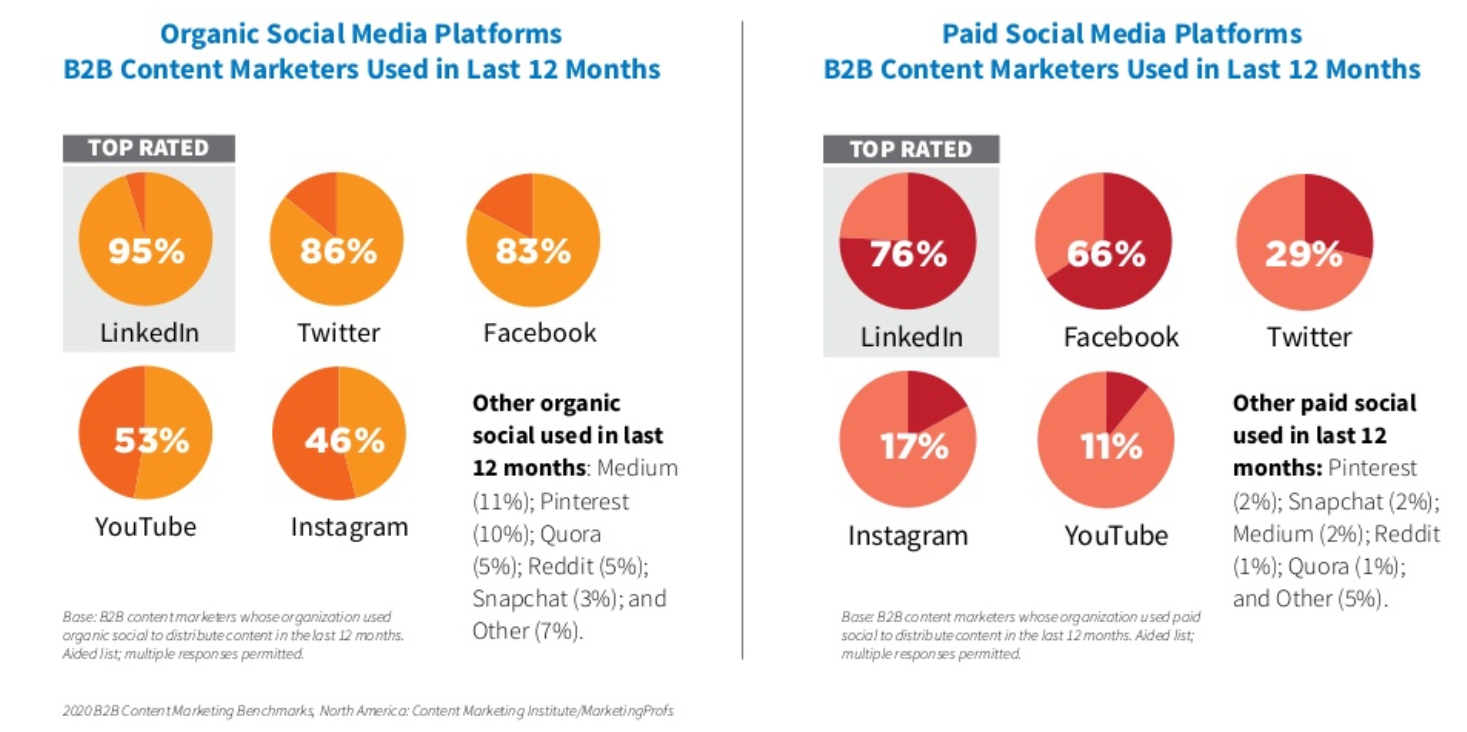
Several factors influence the price of content, including the amount of time it takes to generate and the level of skill required. According to the 2018 State of the Creator Economy Report, the following were the average prices charged:
- White papers: $959
- Videos: $631
- Photographs: $349
- Articles: $249
- Infographics: $185.
Website Costs
A company’s website serves as a calling card for B2B industries, and as a result, businesses invest heavily in custom content. According to WebFX, monthly prices in 2019 might go from $2,000 to $10,000. A blog can help you establish yourself as a trusted advisor in your field and open the door to new business collaborations. The expense of running a blog, on the other hand, can range from $100 to $3,000 for every article. According to Orbit Media, most bloggers in 2019 publish multiple times per month, so it’s easy to understand how rapidly expenses mount.
Social Media Costs
Another area in which large expenditure is frequently required is social networking. A portion of the funding is required for several activities, such as keeping up with Facebook fans or collaborating with YouTube influencers. Consistently posting new content to your website can cost between $1,000 and $5,000 per month.
Keep in mind that the overall cost will be determined by your choices. Hiring a production company to make a video is more cost-effective than purchasing lighting and cameras and having the same content produced internally.
Developing Your Content Marketing System
Developing an effective content marketing system is the most cost-effective approach to do business. A comprehensive system should encompass all aspects of advertising, from the beginning stages of market research through content generation and analysis. Your system will be more effective if it is properly documented and has access to qualified personnel who are familiar with the success measures.
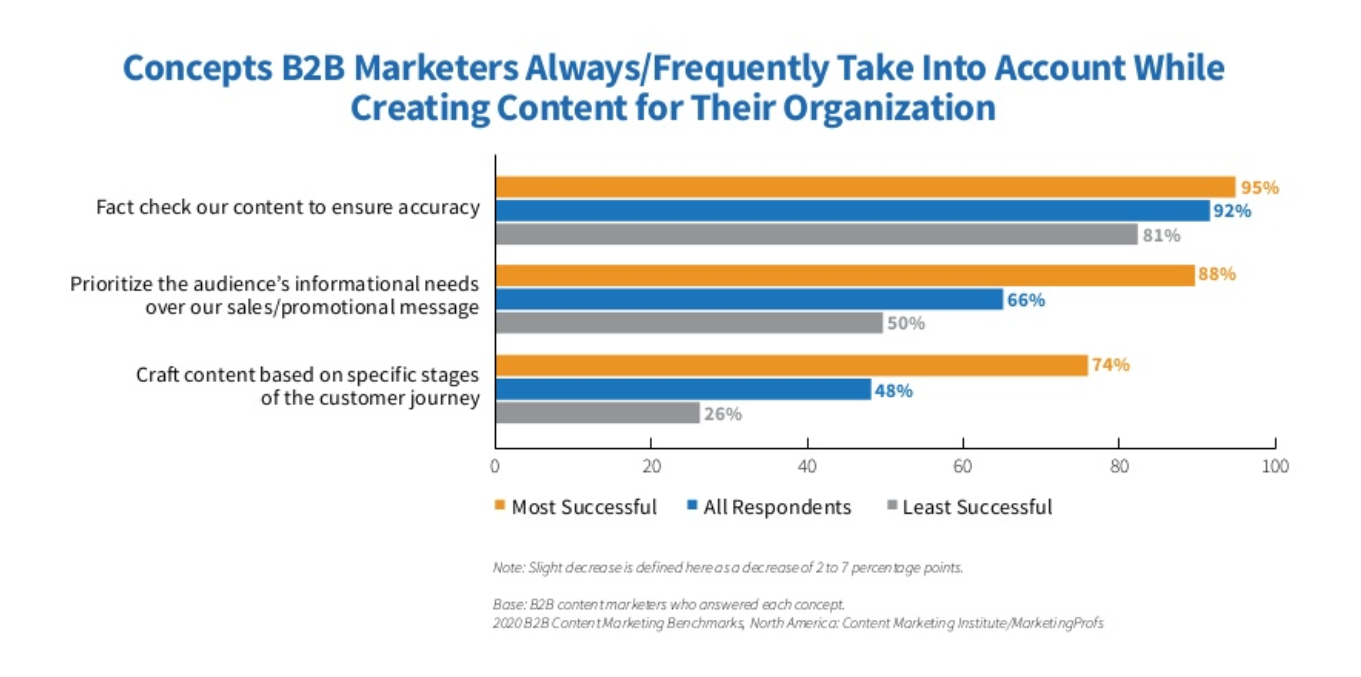
Develop your content marketing approach using one of three methods. To choose the best solution, you should consider the size of your company, the marketing budget you have, and your marketing objectives.
- Freelancer content creators: Freelancers can charge a flat rate, or they can charge by the word, or they can charge based on the success of their material. They’re a good technique to make one-of-a-kind items, but they’re useless for planning and research.
- In-house marketing staff: An in-house marketing team may be the most efficient option for major B2B enterprises. Specialists, content creators, editors, publishers, and data analysts make up a marketing team.
- Outsourcing: For many small- to medium-sized businesses, outsourcing is the most cost-effective solution. Working with a specialized firm allows a company to hire the best employees without having to pay for pricey marketing staff.
How Can I Do Content Marketing on a Budget?
If you don’t have the resources to hire a team of content professionals, you might wonder how to execute B2B content marketing on a budget. We’re ready to assist you if you need it. Each step at a time, we’ll walk you through the seven steps necessary to get started.
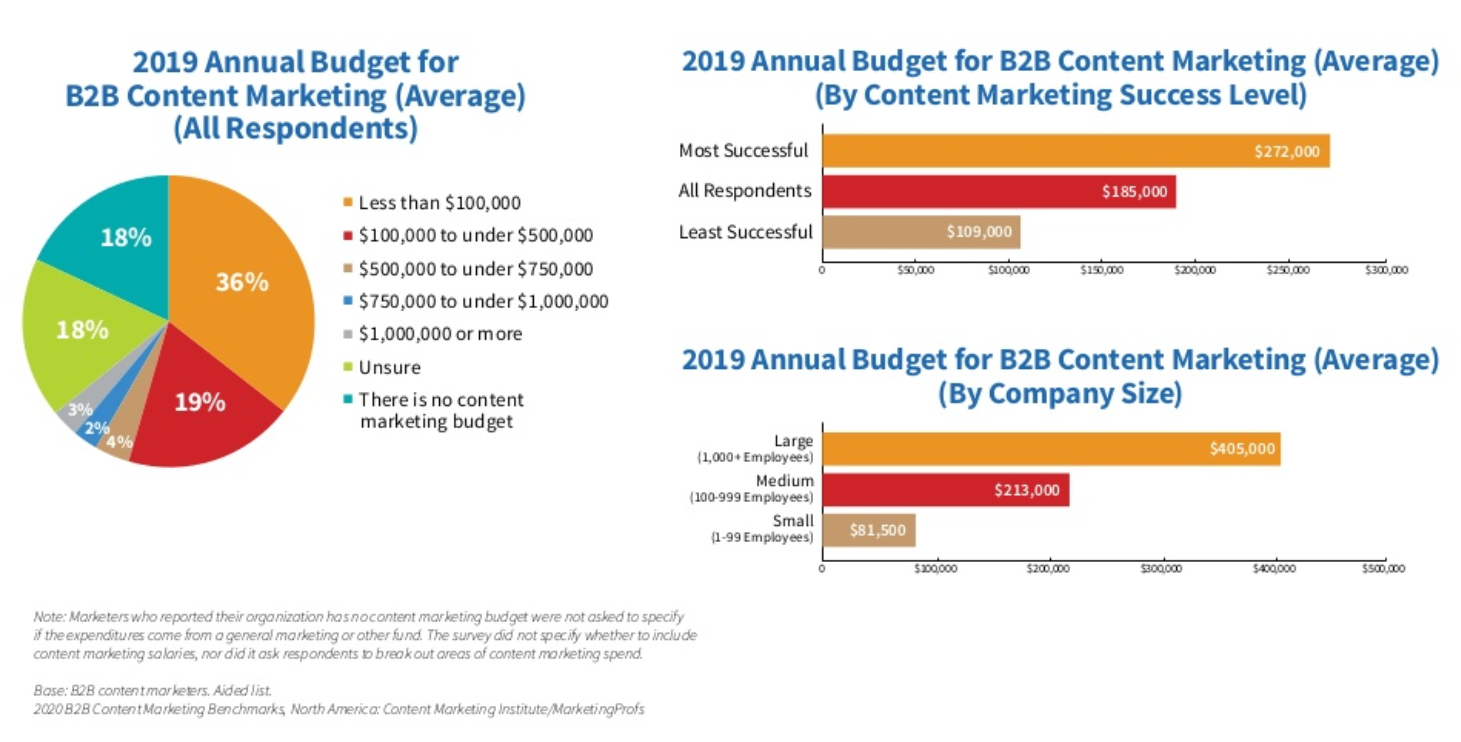
Step 1: Conduct a Content Audit
Start by conducting an organizational content audit to see what you already have. Make a list of everything that’s already on your website and evaluate how well it’s performing.
- Does it address the concerns of B2B buyers?
- Is there a compelling reason for the customer to continue their journey after reading this?
- If so, does it generate high-quality leads?
Finding out what works and doesn’t work is your goal. This will come in handy when you’re writing new content in the future. At this moment, it’s also crucial to inquire about another crucial issue: What am I overlooking?
Using your current content inventory to develop a sales funnel map, you can identify content gaps and work to fill them so that your sales team has more content to work with.
You’ll be able to see what material is required and allocate your marketing money more effectively.
Step 2: Conduct a Competitive Audit
Analyzing your competition and looking for opportunities that they’re missing is the next step. You should conduct a content audit on your main competitors. These audits can be performed manually or with low-cost or free software.
You may also conduct a simple Google search to uncover new content categories to investigate. Enter the search terms and phrases that people are likely to use when looking for information, and then look at the top search results that appear.
This might assist you in identifying the most effective kind of content. It’s helpful to gather B2B content customer insights on your rivals to see which campaigns are most effective at reaching their target demographic as well as which marketing channels they’re using.
Step 3: Create a Content Calendar
To target B2B buyers throughout their customer journey, you’ll need to know which content works and which you should generate based on the information you’ve gathered in phases one and two.
A content calendar is exactly as it sounds like: a list of upcoming articles and other content. Decide on subjects, frequency, and publishing dates before you begin. Your sales team should work together on content marketing.
When at all possible, content efforts should be coordinated with sales activities, new product launches, and sales-focused events. It’s not so much about how often you post as it is about the quality of the content you’re posting. For the time being, quality wins out over quantity. You want visitors to your material to get something of value from it.
Content Marketing Ideas
When planning your content calendar, consider the following tactics for content marketing:
- Content that is evergreen; Content that remains relevant over time is known as evergreen content. For someone at the top of the funnel, answering commonly asked questions and offering how-to tutorials will always be new.
- Content hub; When you’re performing content marketing on a tight budget, the content center is critical. All of your timeless material will be stored here.
- Thought Leadership; Make use of your knowledge and the knowledge of others to create authoritative information.
- Theme-based content; Topical material is based on current events or business trends that are taking place right now.
Each one of these things will help you establish yourself as an industry authority. It builds trust and inspires confidence in your offerings in B2B prospects. It’ll also enhance your B2B site’s search engine optimization. There are free online tools that can help spawn ideas if you’re having trouble coming up with new ones after finishing your audits. These include:
- Google Keyword Planner
- Hubspot’s Blog Idea Generator
- Yahoo! Answers
- Answer the Public
Distribution Channels
When creating your content calendar, keep in mind how you want to distribute it.
If you’re writing a blog article, a guest post, a landing page, a social media post, or an email, be sure to use the correct medium for your message.
B2B content marketing on a budget can be done effectively by creating an anchor piece of content, then customizing it for each distribution channel while still referencing the original.
An email marketing campaign, for example, could use key elements from the article and then reference it for additional information.
Step 4: Creating the Content
It’s time to start putting your thoughts into action. It’s a challenge for most businesses to produce content of the required quality and amount. Here are a few strategies companies use to strike a balance between quality and quantity:
- Invoking the expertise of internal experts and external stakeholders.
- Hiring a content marketing team for your company.
- Utilizing the services of independent contractors to develop.
- To participate, seek out thought leaders in your field and guest bloggers.
Determine the Purpose of the Content
There will be a goal at the beginning of each piece of content: What do you want your reader to do after engaging with your material?
Is your goal for them to contact a sales representative, download a whitepaper, or join your email list? You’ll have to be very clear about your ultimate objective and write with that in mind.
Curation of Content
Curation of content is a different option to think about. It is possible to give a significant service to B2B prospects by gathering and synthesizing content from multiple industry sources.
Step 5: Promotion and Marketing
Right? If you put in the work, people will come. But hold on a second. The sheer volume of online content is mind-boggling. It takes WordPress 60 seconds to add one of the 78 million blog articles that are already there.
This excludes corporate websites, trade publications, and other online media. You’re missing out on the daily brand tweets and social media updates totaling 1.5 million on Facebook and Instagram as well as the 500+ hours of footage uploaded to YouTube each minute.
You’ll also need a strategy for promoting your content once it’s published. Starting with the resource you already have under control is the best way to start B2B marketing on a budget.
- Make an announcement and publish a link to it on your website.
- Include URLs in email signatures for easy access.
- Subscribe to your email list and forward this to them.
- Make use of free social networking tools to narrow your focus.
- Comment on relevant blogs and include a link to your website or blog post in your comment
- Make contact with key decision-makers in the industry.
- Use additional free channels like LinkedIn and Medium to adapt your material
- Use relevant keywords in your material, but don’t overdo it by filling the text with them.
- Include links to other parts of your website from within your articles.
If you’re new to content marketing, you might notice that your content doesn’t appear very high in organic search results at first.
That could be a roadblock for some people. More than a quarter of Google users click on the top result, whereas only about a tenth of those users goes past the first ten results.
It’s worth it to invest in sponsored search and social media marketing to reach a wider audience.
Step 6: Measure It
Understanding what appeals to your prospects is one of the secrets to efficient B2B content marketing.
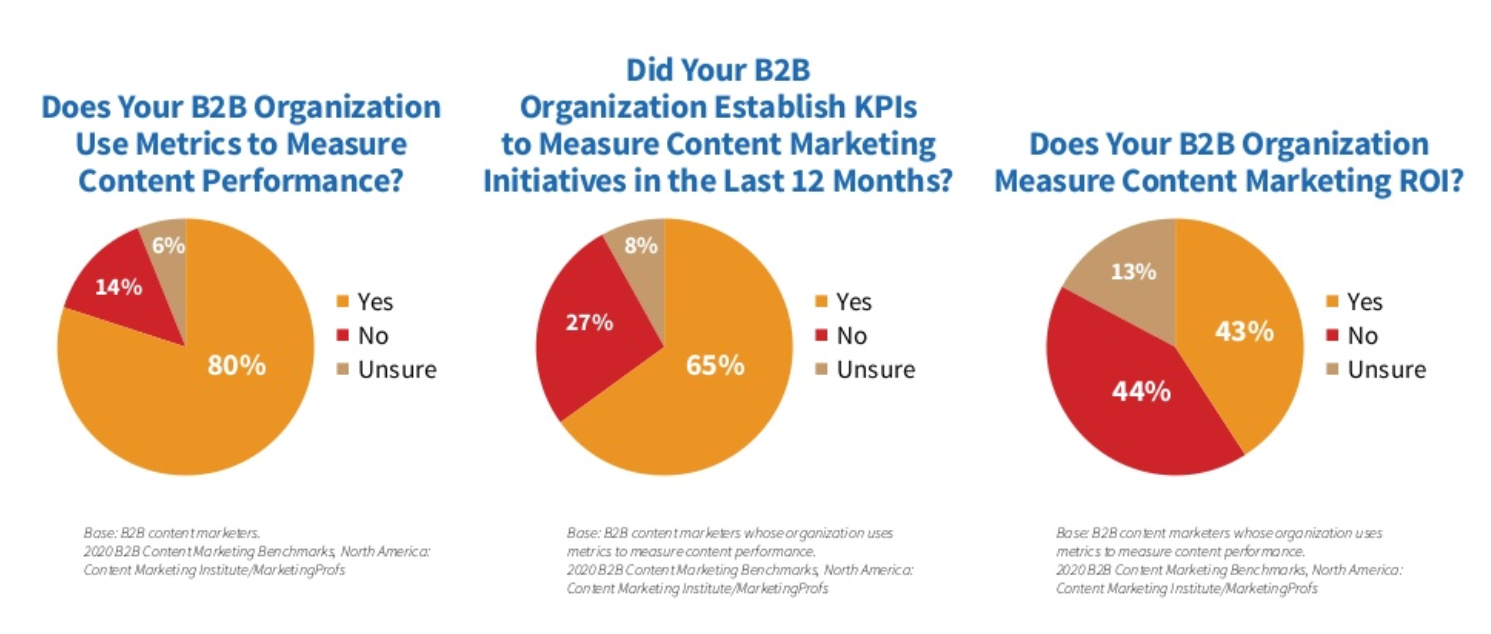
Performance and conversion metrics allow you to see which content is most effective at generating leads, qualifying prospects for the sale, and closing deals.
Observe what works, and then do more of it when you discover what is working. If something isn’t working, figure out why and decide whether or not to fix it.
Content marketing success metrics (and how to keep within your budget!)
Step 7: Repurpose
Don’t be scared to update or extend content that is already performing well for you.
The most effective strategy, according to more than half of B2B marketers, is to update a high-performing, but older control.
- Dissect a single post or blog into several distinct subjects.
- Invent new content formats including infographics, movies, and PowerPoint presentations.
- Expand on successful blog entries with new, in-depth content.
- Add new material or expand existing information to content to make it more current or fresh.
B2B Content Marketing ROI
More than half of B2B companies that are successful with content marketing track their results (source).
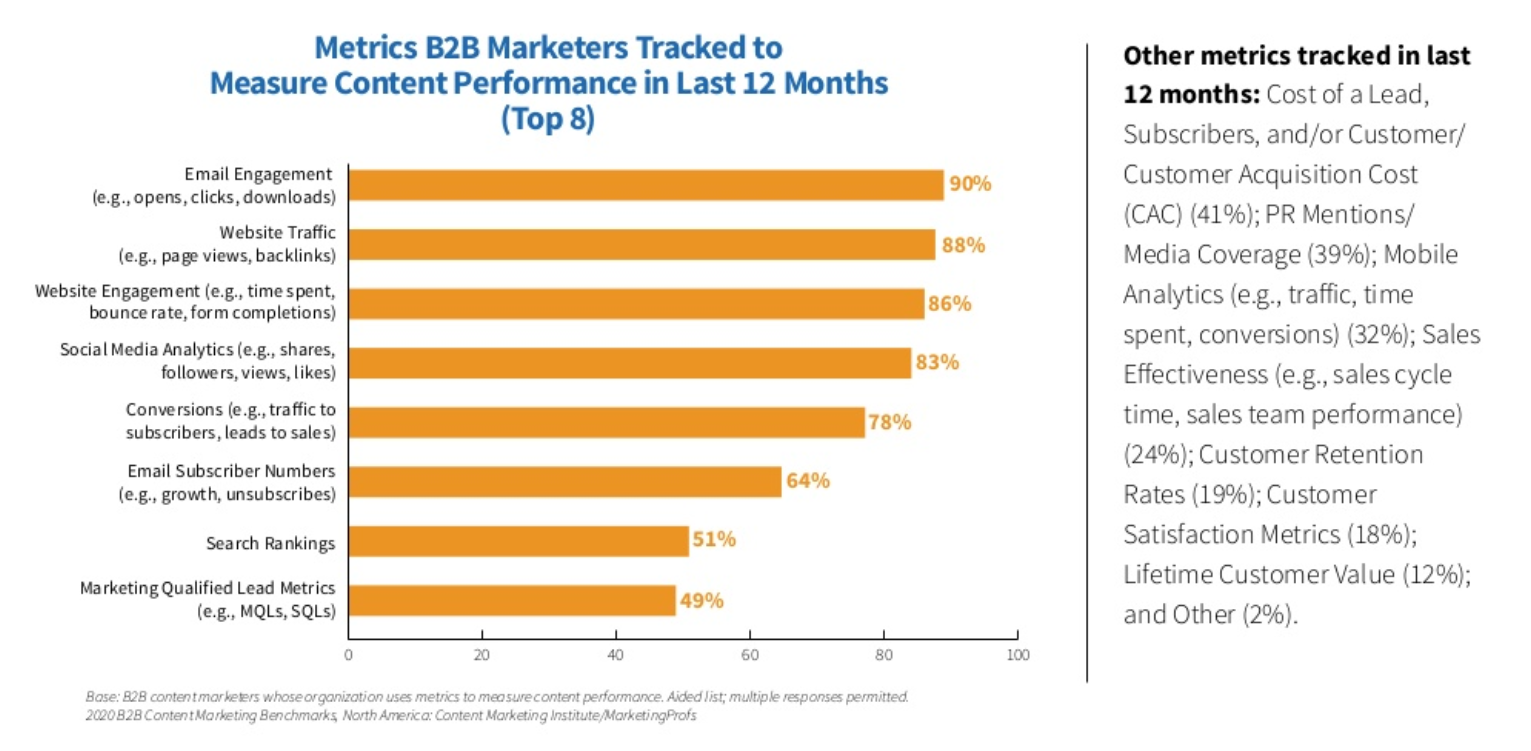
71% of marketing professionals think that crediting social and content revenue is the most difficult hurdle in establishing the ROI of their marketing activities (source).
70% of B2B marketers claim to be able to show through data how content marketing has improved audience interaction and the number of leads they have (source).
The content marketing ROI for B2B companies has been demonstrated by 51% of those companies (source).
Only 25% of B2B marketers could demonstrate a reduction in customer acquisition costs through content marketing (source).
Four-fifths of B2B firms don’t track the return on their content marketing investments because of a lack of formal explanation or a lack of a simple method to do so (source).
54% of the most effective B2B content marketing firms believe measurements are aligned excellently or very well with their content marketing objectives (source).
Web traffic success is measured by 60% of B2B marketers, sales lead quality by 51%, and social media sharing by 45%. (source).
Final Thought
The cost of B2B content marketing varies widely. In the end, it doesn’t matter how much you spend as long as you get value for your money. To be successful, you must have a solid marketing system in place, and that system is only as strong as its weakest link. Spending big bucks on content creation is useless if no one can find it because of poor distribution.
Furthermore, there’s no use in spending a lot of money on content that’s not going to do anything for your business. Analyze your ROI (return on investment) regularly. Recognize patterns, look for flaws in your system, and make adjustments to your strategy. Make the most of every penny you have, no matter how little you have to spend.
